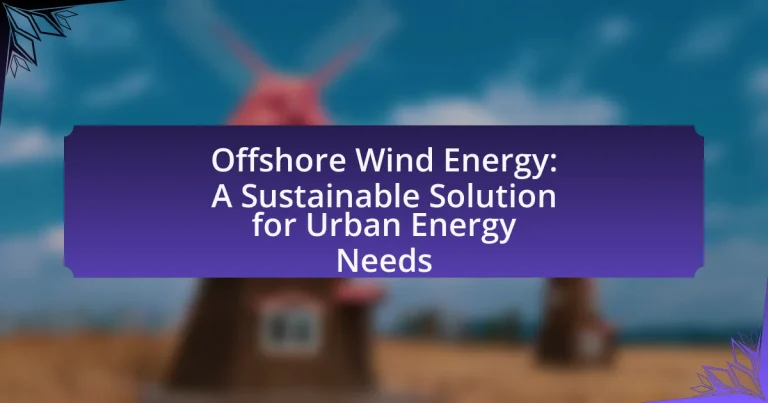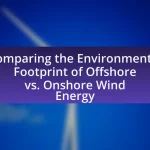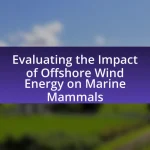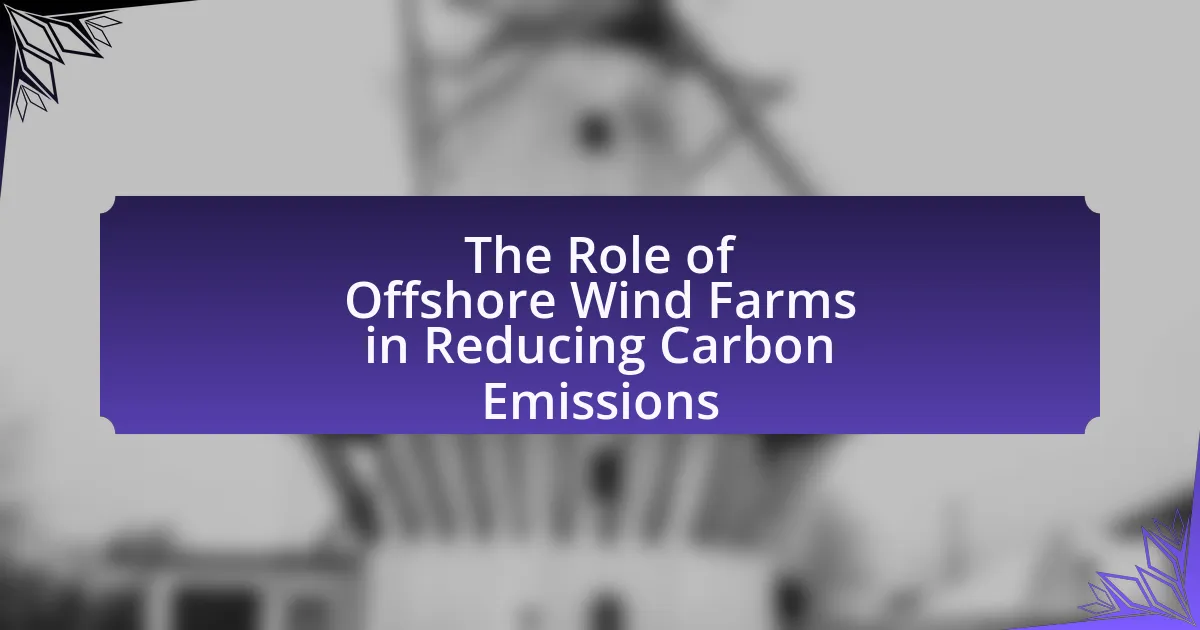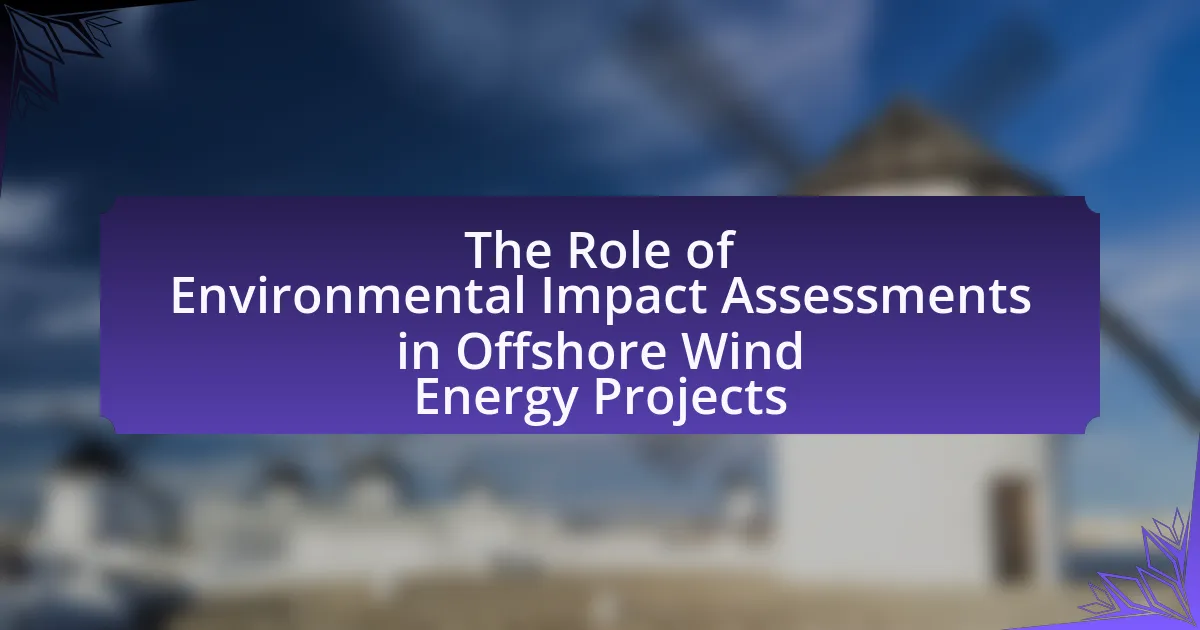Offshore wind energy refers to the generation of electricity through wind turbines situated in bodies of water, primarily on the continental shelf, where wind speeds are stronger and more consistent than on land. This article explores the mechanics of offshore wind energy, its key components, advantages, and its role in sustainability and urban energy needs. It highlights the economic benefits, job creation potential, and the integration of offshore wind energy into existing urban systems, while also addressing challenges and future prospects for this renewable energy source. The discussion includes technological advancements, policy impacts, and best practices for successful project implementation, emphasizing offshore wind energy as a viable solution for reducing urban carbon footprints and enhancing energy security.
What is Offshore Wind Energy?
Offshore wind energy is the generation of electricity using wind turbines located in bodies of water, typically on the continental shelf. This method harnesses stronger and more consistent wind speeds found offshore compared to onshore locations, resulting in higher energy output. According to the Global Wind Energy Council, offshore wind capacity reached over 35 gigawatts globally by the end of 2020, demonstrating its growing significance in renewable energy production.
How does Offshore Wind Energy work?
Offshore wind energy works by harnessing the wind’s kinetic energy through turbines located in bodies of water, typically on the continental shelf. These turbines convert wind energy into mechanical power, which is then transformed into electricity using generators. The offshore location allows for stronger and more consistent winds compared to onshore sites, enhancing energy production efficiency. According to the Global Wind Energy Council, offshore wind capacity reached over 35 gigawatts globally by the end of 2020, demonstrating its growing significance in renewable energy generation.
What are the key components of Offshore Wind Energy systems?
The key components of Offshore Wind Energy systems include wind turbines, substructures, electrical systems, and support vessels. Wind turbines are the primary energy conversion devices that harness wind energy and convert it into electricity. Substructures, such as monopiles or jackets, provide the necessary support for the turbines in marine environments. Electrical systems, including cables and substations, facilitate the transmission of generated electricity to the onshore grid. Support vessels are essential for the installation, maintenance, and operation of the wind farms, ensuring that all components function effectively in offshore conditions.
How do turbines convert wind energy into electricity?
Turbines convert wind energy into electricity by utilizing the kinetic energy of wind to turn blades connected to a rotor, which spins a generator. As wind flows over the turbine blades, it creates lift, causing the rotor to rotate. This mechanical energy is then transformed into electrical energy through electromagnetic induction in the generator. According to the U.S. Department of Energy, modern wind turbines can convert over 40% of the wind’s energy into electricity, making them an efficient source of renewable energy.
What are the advantages of Offshore Wind Energy?
Offshore wind energy offers several advantages, including higher energy generation potential and reduced visual impact. The wind speeds offshore are typically stronger and more consistent than on land, allowing turbines to produce more electricity. According to the U.S. Department of Energy, offshore wind farms can generate up to 50% more energy than their onshore counterparts due to these favorable conditions. Additionally, offshore installations are often located far from populated areas, minimizing visual and noise disturbances for urban residents. This combination of efficiency and reduced impact makes offshore wind energy a compelling option for sustainable urban energy needs.
How does Offshore Wind Energy contribute to sustainability?
Offshore wind energy contributes to sustainability by providing a renewable source of electricity that reduces reliance on fossil fuels. This form of energy generation harnesses wind power over the ocean, where wind speeds are typically higher and more consistent than on land, resulting in greater energy output. According to the International Renewable Energy Agency, offshore wind energy has the potential to generate over 18,000 terawatt-hours of electricity annually, significantly decreasing greenhouse gas emissions and mitigating climate change impacts. Additionally, offshore wind farms create minimal land use conflicts and preserve terrestrial ecosystems, further enhancing their sustainability profile.
What economic benefits does Offshore Wind Energy provide to urban areas?
Offshore wind energy provides significant economic benefits to urban areas, including job creation, increased local investment, and enhanced energy security. The development of offshore wind farms generates thousands of jobs in manufacturing, installation, and maintenance, contributing to local economies. For instance, a report by the U.S. Department of Energy indicated that the offshore wind sector could create over 77,000 jobs by 2030. Additionally, investments in offshore wind projects stimulate local economies through infrastructure development and supply chain enhancements. Urban areas benefit from reduced reliance on fossil fuels, leading to more stable energy prices and improved energy resilience. These factors collectively contribute to economic growth and sustainability in urban environments.
How does Offshore Wind Energy address urban energy needs?
Offshore wind energy addresses urban energy needs by providing a renewable and sustainable source of electricity that can significantly reduce reliance on fossil fuels. Urban areas often face high energy demands, and offshore wind farms can generate large amounts of power due to stronger and more consistent winds found at sea. For instance, a single offshore wind turbine can produce enough electricity to power thousands of homes, contributing to the energy grid and supporting urban infrastructure. Additionally, studies indicate that offshore wind energy can lower greenhouse gas emissions, which is crucial for cities aiming to meet climate targets. According to the International Energy Agency, offshore wind capacity could reach 234 gigawatts globally by 2030, further enhancing its role in meeting urban energy requirements sustainably.
What role does Offshore Wind Energy play in reducing urban carbon footprints?
Offshore wind energy significantly reduces urban carbon footprints by providing a clean, renewable source of electricity that displaces fossil fuel consumption. This transition to wind energy lowers greenhouse gas emissions associated with urban energy use, as wind power generation produces no direct emissions during operation. According to the Global Wind Energy Council, in 2020, offshore wind energy helped avoid approximately 325 million tons of CO2 emissions globally, demonstrating its effectiveness in mitigating climate change impacts in urban areas. By integrating offshore wind into urban energy systems, cities can achieve substantial reductions in their overall carbon emissions, contributing to sustainability goals and improved air quality.
How can Offshore Wind Energy integrate with existing urban energy systems?
Offshore wind energy can integrate with existing urban energy systems by providing a renewable source of electricity that complements urban demand. This integration occurs through the development of offshore wind farms that generate electricity, which is then transmitted via undersea cables to urban grids. For instance, the Hornsea Project in the UK, one of the largest offshore wind farms, supplies power to over a million homes, demonstrating the capability of offshore wind to meet significant urban energy needs. Additionally, energy storage systems can be employed to balance supply and demand, ensuring a stable energy flow to urban areas even when wind conditions fluctuate. This synergy not only enhances energy security but also contributes to reducing greenhouse gas emissions in urban environments.
What are the challenges of implementing Offshore Wind Energy in urban settings?
The challenges of implementing offshore wind energy in urban settings include spatial constraints, regulatory hurdles, and public opposition. Urban areas often have limited available space for wind turbine installation, which can lead to conflicts with existing infrastructure and land use. Additionally, regulatory frameworks may not be adequately developed to address the unique aspects of offshore wind projects, complicating the permitting process. Public opposition can arise due to concerns about visual impacts, noise, and potential effects on marine ecosystems, which can hinder project development. These factors collectively create significant barriers to the successful integration of offshore wind energy in urban environments.
How can cities benefit from Offshore Wind Energy?
Cities can benefit from offshore wind energy by gaining access to a renewable and sustainable power source that reduces greenhouse gas emissions. Offshore wind farms can generate large amounts of electricity, with a single turbine capable of producing enough energy to power thousands of homes. For instance, the Block Island Wind Farm in Rhode Island generates 30 megawatts of power, supplying electricity to approximately 17,000 homes. This transition to wind energy not only helps cities meet their energy demands but also contributes to energy independence and job creation in the renewable energy sector. Furthermore, utilizing offshore wind energy can enhance urban resilience against climate change by diversifying energy sources and reducing reliance on fossil fuels.
What are the potential job creation opportunities associated with Offshore Wind Energy?
Offshore wind energy has the potential to create numerous job opportunities across various sectors. The development, installation, and maintenance of offshore wind farms can generate jobs in engineering, manufacturing, construction, and operations. For instance, a report by the U.S. Department of Energy estimates that the offshore wind sector could support over 77,000 jobs by 2030, driven by the increasing demand for renewable energy sources. Additionally, jobs in supply chain management, environmental assessment, and regulatory compliance are also expected to grow as the industry expands.
How does Offshore Wind Energy enhance energy security for urban populations?
Offshore wind energy enhances energy security for urban populations by providing a reliable and renewable source of electricity that reduces dependence on fossil fuels. This form of energy generation is less susceptible to supply disruptions caused by geopolitical tensions or natural disasters, as wind resources are abundant and widely distributed. According to the Global Wind Energy Council, offshore wind capacity has been growing rapidly, with a global installed capacity of over 35 gigawatts by the end of 2020, indicating its potential to significantly contribute to urban energy needs. By diversifying the energy mix and integrating local offshore wind farms, urban areas can achieve greater resilience against energy shortages and price volatility, ultimately ensuring a stable energy supply for their residents.
What are the future prospects of Offshore Wind Energy?
The future prospects of offshore wind energy are highly promising, with significant growth anticipated in capacity and technology advancements. According to the International Energy Agency (IEA), offshore wind capacity is expected to increase from 35 gigawatts (GW) in 2020 to over 200 GW by 2030, driven by supportive government policies and declining costs. Additionally, innovations in floating wind turbine technology are expanding the potential for offshore wind farms in deeper waters, enhancing energy generation capabilities. This growth is further supported by the global shift towards renewable energy sources, aiming to reduce carbon emissions and combat climate change.
How is technology evolving in Offshore Wind Energy?
Technology in offshore wind energy is evolving through advancements in turbine design, floating platforms, and digitalization. Modern turbines are now larger and more efficient, with capacities exceeding 12 megawatts, which significantly increases energy output. Floating wind farms are being developed to harness wind energy in deeper waters, expanding the potential locations for offshore installations. Additionally, digital technologies, including predictive maintenance and data analytics, enhance operational efficiency and reduce costs. These advancements are supported by industry reports indicating that offshore wind capacity is projected to grow from 35 gigawatts in 2020 to over 200 gigawatts by 2030, demonstrating the rapid evolution and increasing viability of offshore wind energy as a sustainable solution.
What innovations are being developed to improve efficiency in Offshore Wind Energy?
Innovations being developed to improve efficiency in offshore wind energy include larger turbine designs, advanced materials, and digital technologies. Larger turbines, such as those exceeding 12 MW, can capture more wind energy and reduce the cost per megawatt-hour. Advanced materials, like lighter and stronger composites, enhance turbine durability and performance in harsh marine environments. Digital technologies, including predictive maintenance and real-time monitoring systems, optimize operational efficiency and reduce downtime. These innovations collectively contribute to making offshore wind energy more competitive and sustainable, as evidenced by the increasing capacity factors reported in recent projects, which can exceed 50%.
How do policy changes impact the growth of Offshore Wind Energy?
Policy changes significantly influence the growth of offshore wind energy by establishing regulatory frameworks, financial incentives, and investment security. For instance, countries that implement favorable policies, such as feed-in tariffs or tax credits, have seen accelerated development in offshore wind projects; the United Kingdom’s Contracts for Difference scheme has led to a substantial increase in offshore wind capacity, reaching over 10 GW by 2020. Additionally, streamlined permitting processes and government commitments to renewable energy targets create a conducive environment for investment, as evidenced by the European Union’s Green Deal, which aims to increase offshore wind capacity to 300 GW by 2050. These policy changes not only enhance investor confidence but also drive technological advancements and cost reductions in the offshore wind sector.
What are the best practices for implementing Offshore Wind Energy projects?
The best practices for implementing Offshore Wind Energy projects include thorough site assessment, stakeholder engagement, and adherence to regulatory frameworks. Conducting comprehensive environmental impact assessments ensures that potential ecological effects are understood and mitigated. Engaging local communities and stakeholders fosters support and addresses concerns, which is crucial for project acceptance. Compliance with national and international regulations, such as the European Union’s Renewable Energy Directive, ensures that projects meet safety and environmental standards. Additionally, utilizing advanced technology for turbine design and installation can enhance efficiency and reduce costs, as evidenced by the increasing capacity factors of offshore wind farms, which have reached over 50% in some regions.
How can stakeholders collaborate effectively in Offshore Wind Energy initiatives?
Stakeholders can collaborate effectively in Offshore Wind Energy initiatives by establishing clear communication channels and shared goals. Effective collaboration involves regular meetings, joint planning sessions, and the use of collaborative technologies to ensure all parties are aligned on project objectives and timelines. For instance, the Offshore Wind Industry Council in the UK emphasizes the importance of stakeholder engagement through initiatives that include local communities, government bodies, and industry players, which has led to increased project efficiency and public support. Additionally, sharing data and resources among stakeholders can enhance decision-making processes and foster innovation, as demonstrated by successful projects in countries like Denmark, where collaborative frameworks have resulted in significant advancements in offshore wind technology and deployment.
What lessons have been learned from existing Offshore Wind Energy projects?
Existing Offshore Wind Energy projects have demonstrated the importance of robust site assessments and stakeholder engagement. Comprehensive environmental and geological evaluations are crucial for optimizing turbine placement and minimizing ecological impacts, as evidenced by the successful deployment of the Hornsea One project in the UK, which utilized extensive pre-construction surveys to inform its design. Additionally, effective collaboration with local communities and regulatory bodies has proven essential for securing project approvals and fostering public support, as seen in the Block Island Wind Farm in the United States, where community outreach efforts significantly contributed to its acceptance. These lessons highlight the necessity of thorough planning and community involvement in the successful implementation of offshore wind initiatives.
